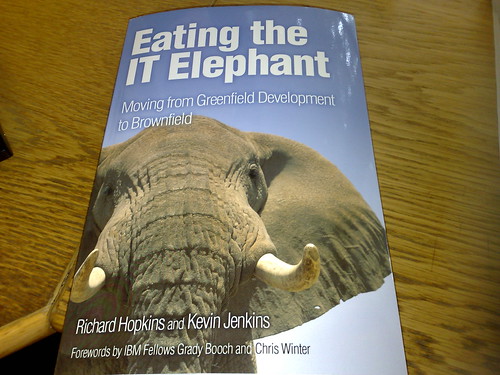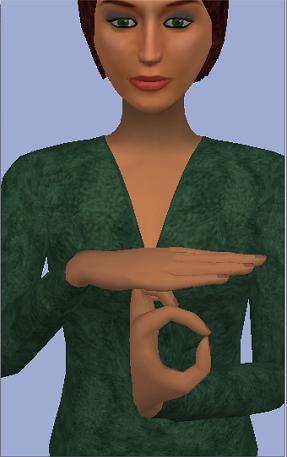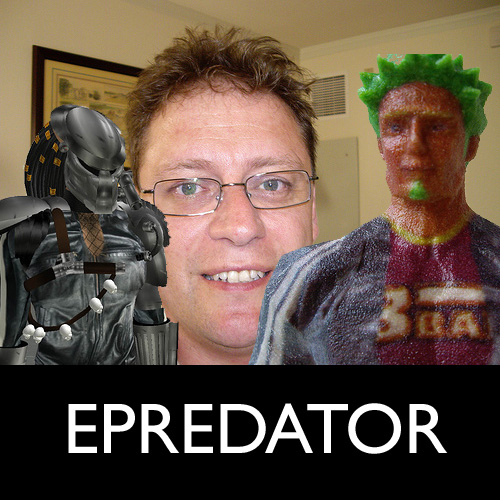I just got the review copy of Richard Hopkins and Kevin Jenkins book Eating the IT Elephant : moving from Greenfield Development to Brownfield.

I have known and worked with Richard for quite a few years so I was very interested when he started to talk about this book, then when this exploded into using Second Life for visualization of existing system architectures (starting on Hursley island) it got me even more interested.

Image from snapzilla
The book is not solely about using virtual worlds to visualize systems, but it is a part of the whole. For any IT architects out there and software engineers many of the themes around complexity with familiar. As will the not so good solutions of representing complex architectures in reduced down powerpoint slides or stickers on a wall.
There is a lot more to the book, and I need to read the rest properly. It has a foreword by Grady Booch and by the one of the UK based IBM fellows Chris Winter. They make interesting reading. Though I really like Richard’s family dedication. I wont spoil that for you 🙂
They have their own site an blog over at elephanteaters.org the book is on amazon the uk link is here
Monthly Archives: May 2008
The Eightbar brand – part 3
Following on from Ian’s posts about the Eightbar gang sign and large hands and sign language in Second Life I have created the Eightbar gang sign using my good friend Anna.
Anna is an animated avatar developed by the University of East Anglia’s eSign project to synthesize sign language, she was used as part of an Extreme Blue project to convert Speech to Sign last summer. Anna is animated using Signing Gesture Mark up Language (SiGML) which is based on the internationally established notation for sign, HamNoSys. Currently, to create signs for Anna, eSign have provided an editor which is very good, but requires a reasonable amount of time to be able to use efficiently. For a few days per week I have been working on a way for people who are not familiar with the eSign editor to create signs for Anna, with the hope that creating signs can be the sort of thing you just dip into, when you have a spare minute and a sign you would like to create. With this in mind I decided, as a test, to create the EightBar gang sign using my interface.
After 15 minutes of playing about, I had a gang sign! It took a few attempts to get there mind…

But finally Anna was throwing the gang sign like a pro…

Metaverse Time Capsule
In case you missed this a couple of months ago, here’s Ren Reynolds (no relation) making sense of the metaverse.
Henrik Bennetsen is making a time capsule, capturing people’s responses to some short questions. Henrik got the ball rolling by uploading some short video interviews he conducted at Metaverse U in Stanford earlier this year, including responses from Sibley Verbeck, Raph Coster, Mark Wallace, Jerry Paffendorf, Corey Bridges, Wagner James Au, Robin Harper, Mitch Kapor, Eric Rice and many more. Cory Ondrejka shared his answers on his blog.
You can add your own responses via the Metaverse U group on YouTube. Although I’m late to the party (and I hate making predictions), I will try to do that myself soon. The questions are:
- What excites you about current metaverse technology?
- What concerns you about current metaverse technology?
- What will be most the surprising impact of metaverse technology on society within the next decade?
- What barriers will metaverse technology never overcome?
Tales from the firepit – The story of a virtual world community
A little while back many of us in eightbar and the wider IBM virtual universe community got to spend time talking to Rita J. King. Rita, or Eureka Dejavu as we all think of her was commissioned to write about how we got to where we are in virtual worlds. The story of a community forming.
The finished article is linked as a PDF from this blog post on Dispatches from the Information Age
It was great too when Rita and Josh came to visit us and we met up in Portsmouth as part of their Dancing Ink Productions world tour. As we always say these virtual worlds are not there to replace real life but add to it. When it means you get to hang out with great people like these it makes it all worth it.
Rita points out how she got to know Grady Booch through doing this piece, a massive figure in software engineering, it was Eureka who introduced me to him at a post virtual worlds conference dinner. To complete the chain a few hundred IBMers were at an award event called the “Corporate Technical Recognition Event” CTRE for short in Phoenix last week. Amongst the lucky award winners was our very own eightbar Daz and here is the picture I took, mainly to show the Peter Kaye lookalike service food in the chef’s hat, but I realized this slightly blurred picture actually also had Grady Booch in it, in the red shirt on the left.

You can read more about the event here and here. I should add that this amazing gathering we were lucky enough to be a part of also included Jeff Jonas who was being made a Distinguished Engineer which is a very big role in IBM. So present company excepted it was a massive gathering of some of the most influential technical people in our massive company. People I would never have got to meet if it had not been for virtual worlds either. Having an IBM Fellow of some note (The most important elected position in IBM for us techies), John Cohn come up to me at the bar and say hey it’s you did my ego the power of good I must say!
That’s enough name dropping and self congratulating, this post is about Eureka’s report
BBC Radio 1 augmenting reality with a ‘band in your hand’
Remember two years ago, when BBC Radio 1 came to Second Life for One Big Weekend? This year they explored augmented reality with a Band In Your Hand. Here’s Scott Mills showing Chappers how it works.
Unfortunately the (Windows-only) download has already been taken down. Why? Because…
Due to music rights restrictions this download was only available from 30.04.08 to 07.05.08
Hugh Garry, Radio 1 interactive producer, describes it in more detail here.
Planet Hursley
Being who we are online and offline – Generation V?
A common theme often emerges when showing people virtual worlds and metaverses. The theme is that of identity. Whilst sometimes this is the more usual business side of identity “how do we know someone is who they are claiming to be” that is actually a slightly different problem to the one that is actually expressed “people are hiding behind their avatar”.
Much of what I present to people is around my online persona as epredator. This is intended to help them understand that we all have projections and labels that we deliver in online interactions. The avatars in virtual worlds just make that slightly more obvious as we have a humanoid puppet with some elements of our name or reputation attached to it.
In SL I tend to be a masked science fiction predator avatar. In my explanations I go on to show that that is not something I hide behind, but is in fact a very expressive facet of my personality, with a link to my regular offline self in that I wear the same leather jacket in RL and SL. I am not choosing to hide who I am, but show more of who I am through the avatar puppet.

This approach is not an obvious one, as very often we take on avatars for games, such as Nico in GTA IV and take on a role to progress a story.
As having an online persona is a bit of a shock to some people, I try and explain they already have one, when they email, or sametime IM someone. Bloggers know they have a voice and a persona they develop for a particular style of post. What people are less likely to contemplate, but are led to do so by the principles of online personas, is that they exist with multiple facets to who they are all the time. People are slightly different at work to at home, with friends and with family.
In business someone might act tough and hard nosed as they are expected to blend with an ideal, yet at home they may be gentle and caring. Having to think who you are and understand how your persona(s) alter those around you is not something many people do. The people who do do this effectively are usually the leaders in organizations, they use their persona(s) in various ways to gather support and push things forward. (There are also people who lie, cheat and steal using multiple personas).
So, the premise here is that being online and having avatar representations or social media profiles is no more dishonest than anything else used in the wrong way. In fact I think there is a lot to be said for trying to make sure that all your personas are integrated, that it is really you, that you do not hide behind any of them, be it position at work, fame and fortune or just an unusual lifestyle.
I was very pleased to see that my anecdotal pop psychology on this matter was justified by this fantastic quote “We get so used to disguising ourselves to others that we end up becoming disguised to ourselves” by the French writer and philosopher The Duke de La Rochefoucauld. I came across this on the fantastic blog Slow Leadership in an article about leaders being genuine at work and not just playing the part. (Which was in turn inspired by an ft article by Stefan Stern.
The Slow Leadership article is specifically referring to bosses and reportees, but I think it has much wider relevance as we start to alter those traditional structures in business (or enterprise 2.0).
The bottom line though is that we can hide behind avatars, just as we can hide behind a desk, a suit, a name plaque, an email address, a front door or a process. Likewise we can actually get to be more integrated and honest individuals able to work, share and play with others with avatars just part of the mix. The disingenuous nature of some people in any field is not a reason ignore metaverses in business.
**Update: I recently read this brilliant description of a change in the generational divide. The term Generation V is used to alude to the change in attitudes across generations. We no longer need to consider Gen X, Gen Y etc, but instead those people that have merged across those generations and operate online with varying degrees of engagement and persona.
The article is well worth a look here from Gartner analyst Adam Sarner
Thanks to Malburns for twittering Giff Constables piece on it that led me to it
Nifty Note Manipulation
Jason Ellis works in IBM Research and maintains a brilliant blog about art and games. In a recent post, he links to this demo video for Melodyne’s new Direct Note Access technology, which looks frankly astonishing.
As the video shows, exploding a sampled chord allows the kind of editing we’re already used to with MIDI sequencers, at the individual note level, now from polyphonic recordings. Wow. I’m particularly blown away by the ability to change the key of a music recording, something I’d previously not even dreamed of.
Great fun for music makers, but Jason also starts thinking about the implications for games.
Imagine the kinds of new music games that could be built, making use of music the original developers never heard or even imagined – building from software that finally understands sound as intimately as the player does.
Exciting stuff.
Rockets in action and I don’t mean salad leaves
On friday a contingent of the Hursley Emerging tech crew (a good few of who are founder members of eightbar) gathered in a Hampshire field to have a rocket launching competition. Fellow eightbar Rob Smart has produced this video of the entire event, its features all the key moments including Dave CJ’s rocket complete with wireless camera to record the flight, and landing (in a tree).
All the rockets were non-explosive, water powered, diet coke powered etc. It was a very good work day out and bonding experience, with a huge dose of geek chic on top of it. There was lots of participation too.
We did this last about 3 years ago, then I remember about 4 cameras. This time it was very well covered in digital form. We have a growing flickr pool if you are interested.
Yet more awards please (no metaverse section though?)
Roo’s very own rooreynolds.com got a mention on this page in the computer weekly blog awards 2008
So in keeping with the desire to collect awards such as the IBM Baffler as well as voting for Roo or Andy Piper why not pop in a vote for eightbar too 🙂
 |
| Nominate me in Web 2.0 and Business |

